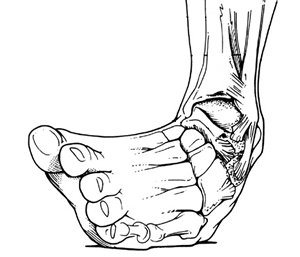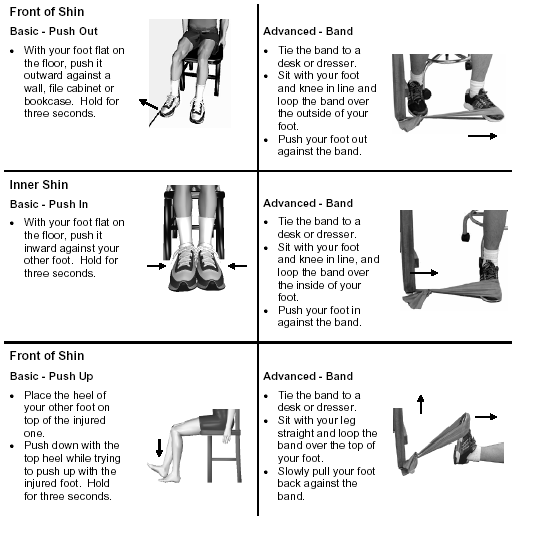Ankle Sprain
A sprain is a twisting injury to the ankle
Most sprains (80%) are caused by rolling the foot inward.

This stretches or tears the ligaments that hold the ankle and foot bones together and can lead to instability and re-injury.

SO WHAT?
Spraining an ankle can increase your risk of re-injury as much as 40-70%. But proper post-injury care, rehabilitation exercises and bracing can decrease this risk. The information below can help you prevent re-injury.
To speed up recovery immediately begin using P - R - I - C - E
Protection - Your ankle may be splinted, taped or braced to prevent further injury.
Rest - You should rest from all activities that cause pain or limping. Use crutches or a cane until you can walk without pain or limping.
Ice - Place a plastic bag with ice on the ankle for approximately 10-20 minutes (you are looking for the skin to turn pink (do not let the skin turn red – this may lead to a burn) 3-5 times a day for the first 24-72 hours.
Leave the ice off for at least 2 hours between applications.
Compression - Wrap a tubigrip or elastic bandage from the toes to just below the knee, using even pressure. Wear this until swelling decreases. Loosen the wrap if your toes start to turn blue or feel cold.
Elevate - Ideally make sure to elevate the ankle above heart level.

Once the injury has settled and the local bleeding has stopped the aim is to:
Restore Normal Ankle Function
Range of Motion Exercises
Help you regain movement.
Technique: Move the foot up and down and from side to side, also rotate the ankle. Repeat 5 of each movements each hour.
Do not force into a painful range.

Flexibility (Stretching) Exercises
Tightness makes it hard to use stairs, walk, run and jump.
Technique: Hold each exercise for 20 seconds at a gentle stretch. Do not bounce!
Frequency: 6-10 repetitions/exercise, 5-7 days per week

Strengthening Exercises
Strong leg muscles help compensate for ligament laxity.
Frequency: Three sets of 20 repetitions, 5 -7 days per week

To Prevent Re-injury
- Continue daily calf and heel stretching, especially after activity (indefinitely)
- Continue ankle strengthening 3-4 days per week (indefinitely)
- Complete the balance tests and exercises (if needed)
- Wear an ankle brace during strenuous activity (indefinitely)
Balance
An ankle sprain can decrease your ability to balance on that foot and makes it easier to roll the ankle
again. As soon as you can stand without pain, try the balance tests below. If you can't balance for
ten seconds without wobbling, practice that level every day until you can. You can stop when you
pass the Level 4 test.
Technique: Balance on your injured foot for ten seconds, do a least 6 repetitions per day.
Goal: Stand 60 seconds without losing your balance, then move to the next level.
Level 1 - Arms out to your side, eyes open
Level 2 - Arms across your chest, eyes open
Level 3 - Arms out to your side, eyes closed
Level 4 - Arms across your chest, eyes closed

Bracing
Injured ligaments can take up to 16 weeks or more to heal. An ankle brace helps protect the ligaments not only during recovery but also when returning to sport or exercise activities.

Common beliefs:
- Bracing can replace strengthening exercises – FALSE! Strong lower leg muscles help provide support to injured ligaments.
- Wearing a brace makes an ankle weaker - FALSE! If you continue your strengthening
This is not a comprehensive reconditioning program and it is advisable to seek assistance from a qualified Chartered Physiotherapist to take you through the rehabilitation process.
If your ankle isn't 80% functional after one month, you are advised to contact your doctor.
If you are concerned about any difference in your treatment plan and the information
in this handout, you are advised to contact your doctor or physiotherapist for further advice.